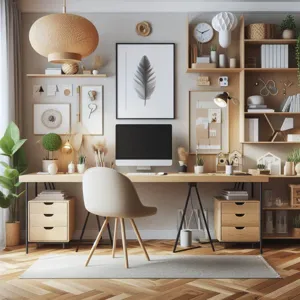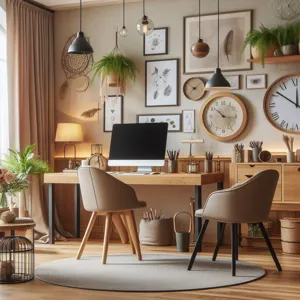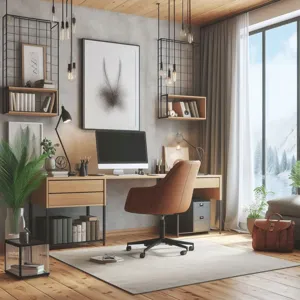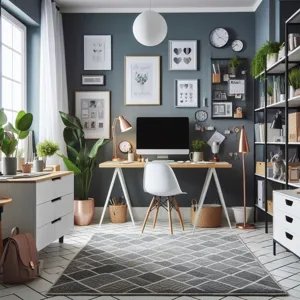In today’s fast-paced digital world, a well-organized home office is more than just a luxury—it’s a necessity for maximizing productivity and maintaining focus.
As remote work becomes increasingly prevalent, the importance of creating a workspace that fosters creativity and efficiency cannot be overstated. From managing clutter to optimizing your layout, the right strategies can transform your office into a sanctuary of productivity. In this blog post, we’ll explore ten essential tips that will help you streamline your work environment, enhance your workflow, and ultimately elevate your performance. Whether you’re a seasoned remote worker or new to the home office setup, these practical insights will guide you in crafting a space that not only inspires productivity but also brings you peace of mind as you tackle your daily tasks. Get ready to unlock your full potential with a home office that works as hard as you do!
1. Assessing Your Space: Understanding Your Needs
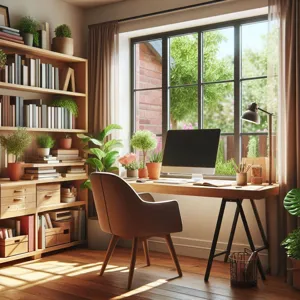
Before diving into the exciting world of home office organization, it’s crucial to start with a thorough assessment of your space and a clear understanding of your unique needs. Take a moment to step back and examine the area you’ll be working in. Is it a dedicated room, a nook in your living space, or perhaps a corner of your dining room? Each configuration comes with its own set of challenges and opportunities.
Begin by considering how you use your workspace. Do you require a large desk for multiple monitors, or do you prefer a minimalist setup with just a laptop? Think about the nature of your work: Are you frequently on calls, requiring a quiet environment, or do you thrive in a bustling atmosphere? Understanding these nuances will help you create an environment that fuels your productivity rather than stifles it.
Next, take stock of your current furniture and equipment. Is your chair ergonomic, supporting long hours of sitting, or does it leave you feeling strained? Does your desk have enough surface area for your essential tools, or is clutter a constant battle? Don’t hesitate to jot down what works for you and what doesn’t. This self-reflection will guide your decisions as you curate your ideal workspace.
Finally, consider the elements that inspire you. Do you find motivation in plants, art, or personal mementos? Incorporating these items into your design can enhance your creativity and create an environment that you genuinely enjoy spending time in. By thoughtfully assessing your space and understanding your needs, you’ll set the foundation for a home office that not only maximizes productivity but also feels uniquely yours.
2. Choosing the Right Location for Your Home Office
Choosing the right location for your home office is a crucial step in fostering an environment that promotes productivity and focus. The ideal spot should be a place where you feel comfortable, inspired, and free from distractions. Begin by evaluating your home layout: look for areas that receive ample natural light, as studies show that exposure to sunlight can enhance mood and energy levels. A well-lit space can also reduce eye strain, making it easier for you to concentrate on your tasks.
Consider the noise level in different rooms. If you have a bustling household, it might be wise to choose a room away from the main living areas, where children or pets may create interruptions. A quieter space can help you maintain a strong focus and minimize distractions. If a separate room isn’t available, think about utilizing a corner of a larger area, such as a living room or bedroom, and use strategic dividers or plants to create a sense of separation.
Additionally, think about how the location aligns with your work habits. Do you thrive in a cozy nook or do you prefer a more open area? Do you need access to specific resources like a printer or filing cabinet? Your workspace should cater to your workflow, allowing for easy access to essential tools and materials.
Lastly, personalization is key. Once you’ve identified the perfect location, make it your own. Infuse your workspace with elements that inspire you—whether it’s artwork, motivational quotes, or plants. This personal touch not only makes the space more inviting but can also boost your creativity and enthusiasm for the tasks at hand. By thoughtfully selecting the right location for your home office, you lay the foundation for a productive work environment that supports your goals and enhances your overall work experience.
3. Decluttering: The First Step to an Organized Office

Decluttering is the cornerstone of creating an organized home office, and it’s often the first step toward maximizing your productivity. Picture this: a workspace overflowing with papers, outdated gadgets, and miscellaneous items can be overwhelming, making it challenging to focus on the tasks at hand. The clutter not only distracts the mind but can also drain your motivation.
To begin your decluttering journey, set aside dedicated time to assess your workspace. Start with a thorough evaluation of every item on your desk and in your drawers. Ask yourself, “Do I use this? Does it serve a purpose?” If the answer is no, it’s time to let it go. Create three categories: keep, donate, and toss. Be ruthless—if an item hasn’t been used in the last six months and doesn’t hold sentimental value, it likely doesn’t belong in your office.
Once you’ve sorted through your belongings, implement an efficient filing system for important documents. Invest in labeled folders, binders, or digital tools that help you easily access what you need without sifting through piles of paper. For items that you frequently use, consider storage solutions that keep them within arm’s reach yet neatly organized, such as drawer organizers or decorative boxes.
Don’t forget to declutter your digital workspace as well. A disorganized desktop filled with files and applications can be just as distracting as a messy physical space. Take some time to organize your digital files into clearly labeled folders, delete what you no longer need, and create a streamlined system that enhances your workflow.
By prioritizing decluttering, you’ll not only clear the physical space around you but also create a mental environment conducive to focus and creativity. With a fresh, organized office, you’ll find that you can tackle your tasks with renewed energy and clarity, leading to increased productivity and success in your work.
4. Essential Furniture for Comfort and Productivity
When it comes to creating an efficient home office, the right furniture is not just a luxury; it’s a necessity. Comfort and productivity go hand in hand, and investing in quality furniture can make all the difference in your work-from-home experience.
Start with an ergonomic chair that supports your posture throughout long hours of sitting. Look for features like adjustable height, lumbar support, and breathable material to ensure you stay comfortable and focused. A well-designed chair will prevent fatigue and discomfort, allowing you to concentrate on your tasks without distraction.
Next, consider your desk space. A sturdy, spacious desk can significantly enhance your workflow. Whether you prefer a traditional style or a modern standing desk, ensure it accommodates all your essential tools—like your computer, documents, and stationery—without feeling cluttered. If you’re short on space, opting for a wall-mounted desk can help you maximize your area while still providing a dedicated workspace.
Don’t forget about additional furniture pieces that promote organization and ease. Storage solutions like shelves, cabinets, or filing systems are invaluable for keeping your workspace tidy and efficient. A clean environment fosters a clear mind, so have a designated place for everything, from books and supplies to important paperwork.
Finally, consider the overall aesthetic of your office. Incorporating elements like a cozy reading nook, decorative plants, or personal touches can create a warm and inviting atmosphere that inspires creativity. A well-thought-out office layout, paired with the right furniture, will not only enhance your comfort but also elevate your productivity, making it easier to tackle your daily tasks with enthusiasm.
5. Effective Desk Setup: Ergonomics Matter
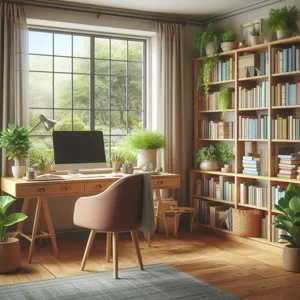
Creating an effective desk setup is pivotal for enhancing productivity and maintaining your well-being while working from home. Ergonomics, the science of designing your workspace to fit your body, plays a crucial role in this equation. The right ergonomic setup not only helps prevent discomfort and injury but also boosts your focus and efficiency.
Begin with your chair, as it serves as the cornerstone of your workspace. Opt for an adjustable chair that supports your lower back and encourages good posture. Ideally, your feet should rest flat on the floor, with your knees at a 90-degree angle. Consider using a footrest if your chair is too high, or adjusting your desk height to accommodate your seated position.
Next, pay attention to your desk height. Your elbows should rest comfortably at a 90-degree angle when typing, with your wrists straight and hands slightly above the keyboard. If your desk is too high or too low, it can lead to fatigue and strain over time. An adjustable desk or a standing desk converter can offer flexibility, allowing you to alternate between sitting and standing throughout the day.
Monitor placement is another critical aspect of an effective desk setup. Position your monitor at eye level, approximately an arm’s length away, to reduce neck strain and promote better posture. If you use multiple monitors, ensure they are aligned and at the same height to avoid awkward neck movements.
Don’t overlook the importance of keyboard and mouse placement, either. These should be situated close enough that you can use them without stretching your arms, and your wrists should remain in a neutral position. Consider using wrist supports if you find yourself frequently experiencing discomfort.
Finally, take the time to personalize your workspace with elements that inspire and motivate you, such as plants, artwork, or motivational quotes. A visually appealing environment can enhance your mood and keep you engaged in your work.
By prioritizing ergonomics in your desk setup, you’ll create a workspace that not only caters to your physical needs but also fosters a productive atmosphere, allowing you to focus on what truly matters—getting the job done efficiently and comfortably.
6. Smart Storage Solutions: Maximizing Vertical and Horizontal Space
In the quest for an organized home office, utilizing smart storage solutions can make all the difference in enhancing your productivity. When space is limited, it’s essential to think creatively about how to maximize both vertical and horizontal areas to keep your workspace tidy and efficient.
Start by taking advantage of vertical space. Wall-mounted shelves, pegboards, and floating cabinets provide ample room for books, office supplies, and decorative items without encroaching on your desk area. By elevating your storage, you not only free up valuable surface space but also draw the eye upward, creating an illusion of a larger, more open environment. Consider installing a corkboard or magnetic board above your desk to keep important reminders and documents within easy reach while maintaining a clutter-free workspace.
On the horizontal front, think about multi-functional furniture. A desk with built-in drawers or shelves can house essential items while keeping your workspace clear. Utilize under-desk storage solutions, such as rolling carts or file cabinets, to keep files and materials organized yet accessible. Slim, stackable bins can be a game-changer for organizing miscellaneous items like chargers, stationery, or paperwork that tends to pile up.
Additionally, use baskets or decorative boxes to corral smaller items. Labeling these containers not only aids in quick identification but also encourages a habit of returning items to their designated spots. With a focus on both vertical and horizontal organization, you can create a home office that fosters creativity and focus, empowering you to tackle tasks with renewed energy and enthusiasm. Embrace these smart storage solutions, and watch your productivity soar as you transform your workspace into a well-organized haven.
7. Organizing Digital Files and Documents
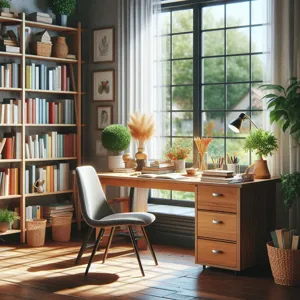
In the digital age, a cluttered digital workspace can be just as distracting as a messy physical desk. Organizing your digital files and documents is crucial for maximizing productivity and ensuring that you can find what you need when you need it. Start by creating a logical folder structure that mirrors the way you think and work. For instance, categorize your files into main folders such as “Projects,” “Clients,” “Finance,” and “Resources.” Within each main folder, create subfolders to further organize your documents. This hierarchical approach not only streamlines access but also helps you maintain focus on the task at hand.
Another essential aspect of digital organization is naming conventions. Use clear, descriptive file names that include relevant dates or project details. This way, a quick glance will tell you exactly what a file contains without needing to open it. Consider using date formats (e.g., YYYY-MM-DD) to ensure that your files are sorted chronologically, making it easier to find the latest version of any document.
Regularly decluttering your digital space is equally important. Set aside time each month to review your files, delete duplicates, and archive outdated documents. Utilizing cloud storage solutions can also enhance your organization efforts, as they often come equipped with robust search functions that allow you to locate files quickly. Plus, cloud storage ensures that your documents are accessible from anywhere, making remote work seamless.
Finally, consider using productivity tools and apps designed for file management. Tools like Trello or Asana can help you keep track of projects, while Google Drive or Dropbox can keep your files organized and easily shareable. By investing time in organizing your digital files and documents, you’ll create a streamlined workflow that fosters focus and efficiency, setting you up for success in your home office.
8. Creating a Distraction-Free Environment
Creating a distraction-free environment is essential for fostering maximum productivity in your home office. In today’s fast-paced world, it’s all too easy to get sidetracked by the myriad of potential interruptions, from the allure of social media notifications to the tempting siren call of household chores. To combat these distractions, the first step is to establish a dedicated workspace that is solely dedicated to your professional tasks. Ideally, this space should be separate from personal areas in your home, allowing you to mentally shift gears when you enter.
Next, consider the layout and organization of your office. Keep your desk clear of clutter, and only display items that are necessary for your work. Invest in storage solutions like filing cabinets, shelves, and desk organizers to keep paperwork and supplies neatly stowed away. A clean workspace can significantly enhance focus, allowing your mind to concentrate on the task at hand rather than getting lost in disarray.
Lighting plays a crucial role in creating a distraction-free environment. Natural light is ideal, as it can boost mood and energy levels, but if that’s not an option, opt for soft, adjustable lighting that reduces glare and eye strain. Additionally, consider using noise-canceling headphones or playing soft background music to drown out ambient noises that may disrupt your concentration.
Lastly, set boundaries with those around you. Clearly communicate your work hours and the importance of minimizing interruptions during this time. By establishing these guidelines, you signal to others that your work is a priority, helping you maintain focus and productivity throughout your day. By implementing these strategies, you can transform your home office into a sanctuary of concentration, empowering you to achieve your goals while enjoying the flexibility of remote work.
9. Incorporating Personal Touches for Inspiration
Creating a home office that fosters productivity often requires more than just a functional layout and the right technology; it also involves infusing your workspace with personal touches that inspire and motivate you. Personalization can transform a sterile environment into a creative sanctuary, reflecting your personality and igniting your passion for work.
Start by displaying items that hold sentimental value or inspire you daily. This could be photographs of loved ones, artwork that resonates with you, or mementos from memorable trips. Each item serves as a reminder of what you value most, helping to cultivate a positive mindset as you tackle your tasks. Consider a vision board filled with quotes, images, and goals that speak to your aspirations—this visual reminder can spark creativity and keep you focused on your objectives.
Incorporating plants into your office is another effective way to bring life and energy into your workspace. Studies have shown that greenery can enhance mood, reduce stress, and increase overall productivity. Choose low-maintenance plants like succulents or snake plants if you’re not confident in your gardening skills. Their vibrant presence will not only purify the air but will also create a calming atmosphere conducive to deep concentration.
Additionally, don’t underestimate the power of color. Choose a color scheme that energizes you. Perhaps you prefer the calming effects of blues and greens, or maybe you thrive in a more vibrant space with pops of yellow or orange. Use desk accessories, wall art, or even the paint on your walls to create an environment that resonates with your style and boosts your motivation.
Ultimately, your home office should be a reflection of who you are, a space that welcomes you each day and encourages your best work. By incorporating personal touches that inspire you, you’ll not only enhance your productivity but also create a workspace that feels uniquely yours—where creativity flows effortlessly and work feels less like a chore and more like a rewarding endeavor.
10. Utilizing Office Supplies Wisely
Utilizing office supplies wisely is crucial for maintaining an organized and productive home office. A well-stocked workspace doesn’t just mean having an abundance of supplies; it means strategically choosing and arranging them to enhance your workflow and minimize clutter. Start with the basics: pens, notepads, sticky notes, and highlighters. Invest in quality items that will last longer and perform better, reducing the need for constant replacements.
Consider implementing a system for your supplies that promotes easy access and efficient use. Use drawer organizers or desktop caddies to keep frequently used items within reach while reserving larger storage solutions for less commonly needed supplies. Categorize your materials—keep all writing tools together, and designate a section for paper products like notebooks and sticky notes. Clear labeling can further streamline your process, ensuring you know exactly where everything is at a glance.
To maximize your space, think beyond traditional supplies. Utilize digital tools such as project management apps and cloud storage to minimize physical paperwork. Not only does this declutter your desk, but it also ensures that important documents are readily accessible without the risk of misplacement. Additionally, consider incorporating multifunctional items, such as a printer that scans and copies, to reduce the need for various devices and save space.
Finally, don’t forget about the aesthetic appeal of your office supplies. Choose items that resonate with your personal style, whether they are sleek and modern or colorful and fun. This not only makes your workspace more inviting but also keeps you motivated and engaged throughout the day. By utilizing office supplies wisely, you can create a streamlined, efficient, and inspiring environment that sets the stage for maximum productivity.
11. Establishing a Routine for Maintenance
Establishing a routine for maintenance is crucial in ensuring that your home office remains a productive haven rather than a chaotic workspace. Just like any other aspect of our lives, consistency is key. Set aside a specific time each week dedicated to tidying up your office—this could be a quiet Sunday morning or a mid-week refresh during your lunch break. During this time, tackle clutter, file away important documents, and ensure that your workspace is not just functional but also inviting.
Incorporate small habits into your daily routine that help maintain order. For instance, commit to a “clean desk” policy by taking a few minutes at the end of each workday to clear your desk of unnecessary items. This could mean putting away papers, wiping down surfaces, or organizing your digital files. Invest in organizational tools like drawer dividers, file organizers, or cable management solutions to streamline this process and make it easier to maintain your workspace.
Additionally, consider establishing a monthly deep-clean schedule. This can involve decluttering your office supplies, dusting surfaces, and reorganizing furniture for optimal comfort and functionality. By making maintenance a regular part of your routine, you’ll not only create a more pleasant working environment but also boost your productivity in the long run. A well-organized space fosters clarity of thought and helps to minimize distractions, enabling you to focus on what truly matters—getting the job done.
12. Tips for Managing Time and Tasks Efficiently
Managing time and tasks efficiently is crucial for creating a productive home office environment. In a space where distractions abound and the lines between work and home life can blur, having a robust time management strategy is essential. Here are some practical tips to help you stay organized and focused throughout your workday.
**1. Prioritize Your Tasks:** Start each day by identifying your most important tasks. Use tools like the Eisenhower Matrix to distinguish between what’s urgent and what’s important, allowing you to focus on high-impact activities that drive results.
**2. Set Specific Goals:** Break down larger projects into manageable, bite-sized goals. This not only makes daunting tasks feel achievable but also provides a sense of accomplishment as you tick them off your list. Consider using SMART criteria—specific, measurable, achievable, relevant, and time-bound—to formulate your goals.
**3. Use a Digital Planner or Task Manager:** Embrace technology by utilizing digital planners or task management apps like Trello, Asana, or Todoist. These tools help you visualize your tasks, set deadlines, and remind you of upcoming priorities, ensuring nothing slips through the cracks.
**4. Implement Time Blocking:** Allocate specific blocks of time for different tasks or types of work. For example, designate mornings for creative tasks when your mind is fresh and afternoons for meetings or administrative work. This structured approach can enhance focus and reduce decision fatigue.
**5. Establish a Routine:** Creating a consistent daily routine helps signal to your brain when it’s time to work and when it’s time to relax. Start your day with a morning ritual that prepares you for productivity—whether it’s a cup of coffee, a quick workout, or quiet reflection.
**6. Limit Distractions:** Identify your biggest distractions and take proactive steps to minimize them. This might mean turning off social media notifications, setting boundaries with family members during work hours, or using noise-canceling headphones to block out background noise.
**7. Schedule Breaks:** Don’t forget to incorporate short breaks into your day. Techniques like the Pomodoro Technique—working for 25 minutes followed by a 5-minute break—can boost your productivity while preventing burnout. Use these breaks to stretch, grab a snack, or practice mindfulness.
**8. Reflect and Adjust:** At the end of each week, take a moment to reflect on what worked and what didn’t. Adjust your strategies as necessary, experimenting with different time management techniques until you find the perfect fit for your workflow.
By implementing these time and task management tips, you’ll create a home office environment that fosters productivity and keeps you focused on your goals. With a little planning and discipline, you can turn your workspace into a powerhouse of efficiency, making the most of your time and minimizing stress.
13. The Role of Lighting in Productivity
Lighting plays a pivotal role in shaping the atmosphere of your home office, directly influencing your productivity, mood, and overall well-being. A well-lit workspace can transform a dreary corner into an inspiring hub of creativity, while insufficient or harsh lighting can lead to fatigue and decreased focus.
Natural light is often the gold standard when it comes to home office illumination. Studies have shown that exposure to daylight can enhance your mood, boost energy levels, and improve concentration. If possible, position your desk near a window to take advantage of this natural resource. The warm glow of sunlight can invigorate your work sessions, making tasks feel less daunting. Additionally, consider using sheer curtains that allow diffused light to flood the space without causing glare on your computer screen.
However, not everyone is fortunate enough to have a sun-drenched office. In those cases, artificial lighting becomes essential. Opt for a combination of ambient, task, and accent lighting to create a well-balanced environment. Ambient lighting serves as the overall illumination, ensuring the room is bright enough to work in. Task lighting, such as desk lamps with adjustable brightness, provides targeted light for specific activities—ideal for reading documents or writing notes. Accent lighting, like wall sconces or decorative fixtures, can add a touch of personality to your space while enhancing the overall ambiance.
When selecting light bulbs, consider their color temperature. Warmer tones (around 2700K to 3000K) create a cozy, inviting atmosphere, while cooler tones (4000K and above) promote alertness and clarity, making them ideal for focus-intensive tasks. Investing in smart lighting solutions can also allow you to adjust brightness and color temperature according to your needs throughout the day.
Finally, don’t underestimate the importance of reducing glare and reflections, especially if you spend long hours in front of a screen. Position your monitor away from direct light sources and use anti-glare screens if necessary. By thoughtfully considering your lighting choices, you can create a home office that not only looks good but also fosters productivity, creativity, and a sense of well-being.
14. Technology Tools to Keep You Organized
In today’s fast-paced world, leveraging technology is essential for creating an organized and efficient home office. With the right digital tools at your fingertips, you can streamline your workflow, manage tasks effortlessly, and keep your workspace clutter-free. Here are some must-have technology tools that can help you stay organized and boost your productivity.
**1. Project Management Software:** Tools like Trello, Asana, or Monday.com allow you to break down your projects into manageable tasks, set deadlines, and track your progress. These platforms offer visual boards and lists that can help you prioritize your workload and ensure nothing falls through the cracks.
**2. Digital Note-Taking Apps:** Gone are the days of scribbling notes on sticky pads. Apps like Evernote, OneNote, or Notion enable you to capture ideas, create to-do lists, and organize your thoughts in one central location. With features like tagging and powerful search capabilities, you can easily retrieve important information when you need it.
**3. Cloud Storage Solutions:** Services like Google Drive, Dropbox, or Microsoft OneDrive provide a safe space for your documents and files. By storing your work in the cloud, you can access it from anywhere, collaborate with others in real-time, and ensure that your important files are backed up and secure.
**4. Time Management Tools:** Keep track of how you spend your time with tools like Toggl or RescueTime. These apps help you identify productivity patterns, manage distractions, and allocate your hours effectively, allowing you to create a schedule that maximizes your output.
**5. Communication Platforms:** Staying connected with team members or clients is crucial for a productive home office. Utilize platforms like Slack, Microsoft Teams, or Zoom for seamless communication and collaboration. These tools facilitate quick discussions, video meetings, and file sharing, helping you stay in sync with your colleagues.
**6. Task Automation Tools:** Simplify repetitive tasks with automation tools like Zapier or IFTTT. These platforms allow you to create workflows that automatically trigger actions between different apps, saving you time and reducing manual effort.
By integrating these technology tools into your home office, you can create a structured environment that fosters productivity and minimizes distractions. Embrace the digital age and watch as your organization skills and efficiency soar to new heights.
15. Regularly Reviewing and Adjusting Your Setup for Optimal Performance
Creating a productive home office isn’t a one-and-done task; it requires ongoing attention and refinement. Regularly reviewing and adjusting your setup is essential to ensure that your workspace continues to meet your evolving needs and preferences. Start by setting aside time—perhaps monthly or quarterly—to evaluate the effectiveness of your current arrangement. Are you still comfortable in your chair, or has it begun to feel less supportive? Is your desk height still ideal for long hours of work, or are you finding yourself slouching or straining your neck?
Consider the tools and technology you use daily. Are there new apps or gadgets that could enhance your workflow? Perhaps you’ve discovered that a standing desk would better suit your working style, allowing for healthier posture and increased energy levels throughout the day. Additionally, take a moment to assess your organization systems. Are your files cluttered, or is your digital workspace in disarray? Streamlining these areas can significantly reduce distractions and enhance your focus.
Don’t forget to seek feedback from your own experiences and, if applicable, from colleagues or family members who share the space with you. They might offer insights into what works well and what could be improved. By making it a habit to regularly review and adjust your home office setup, you not only promote optimal performance but also create an environment that reflects your personal style and supports your productivity goals. A well-tuned workspace can lead to greater inspiration, increased efficiency, and ultimately, a more fulfilling work experience.
In conclusion, creating an organized home office is a vital investment in your productivity and overall well-being. By implementing the 10 essential tips we’ve shared, you can transform your workspace into a haven of focus and efficiency. From decluttering and establishing a designated workspace to incorporating inspiring decor and ergonomic furniture, each step plays a crucial role in fostering a productive environment. Remember, a well-organized office not only enhances your workflow but also promotes a sense of calm and clarity. As you embark on this journey, take the time to personalize your space and create an atmosphere that inspires creativity and motivation. Happy organizing, and may your newfound productivity lead to great success in all your endeavors!

